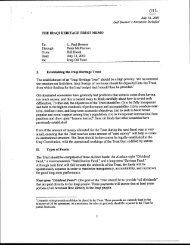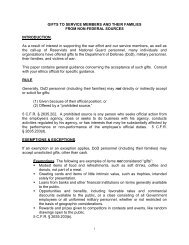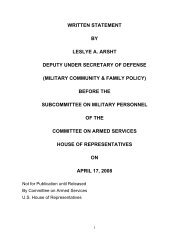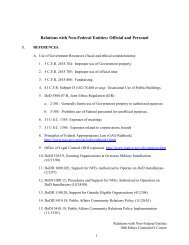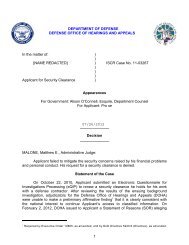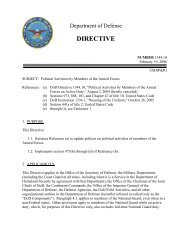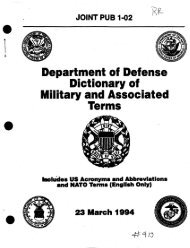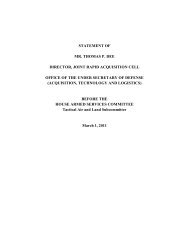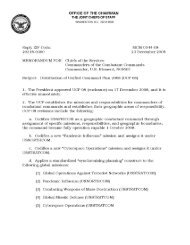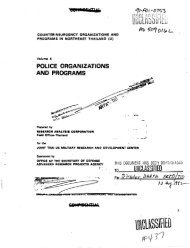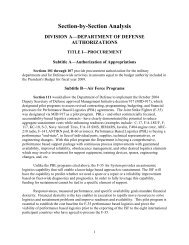dod tactical herbicide sites - United States Department of Defense
dod tactical herbicide sites - United States Department of Defense
dod tactical herbicide sites - United States Department of Defense
You also want an ePaper? Increase the reach of your titles
YUMPU automatically turns print PDFs into web optimized ePapers that Google loves.
Summary <strong>of</strong> Assessment <strong>of</strong> Site ExposureThe issue <strong>of</strong> “meaningful exposure” to Tactical Herbicides is a subject <strong>of</strong> debate in thescientific literature. The most reliable information has shown that the esters <strong>of</strong> the<strong>herbicide</strong>s, 2,4-D and 2,4,5-T, that made up Herbicide Orange, and its associated dioxincontaminant (2,3,7,8-tetrachlorodibenzo-p-dioxin, TCDD) rapidly dried within minutes<strong>of</strong> being sprayed on vegetation, rendering them unavailable for absorption. The process<strong>of</strong> drying involved the chemicals being absorbed within the waxy layer <strong>of</strong> the plantcuticle, where they were not readily dislodged [1]. Studies <strong>of</strong> Herbicide Orange and theassociated TCDD on both leaf and soil surface demonstrated that photolysis rapidlydecreased the concentration <strong>of</strong> TCDD (within hours), and this process even continued inshade [2]. Studies <strong>of</strong> ‘dislodgeable foliar residues’ (the fraction <strong>of</strong> a substance that isavailable for cutaneous uptake from the plant leaves) showed that only 8% <strong>of</strong> werepresent 1 hour after application. This dropped to 1% 24 hours after application [3].Moreover, studies in human volunteers confirmed that after 2 hours <strong>of</strong> saturated contactwith bare skin, only 0.15-0.46% <strong>of</strong> 2,4,5-T entered the body and was eliminated in theurine [4]. The implications <strong>of</strong> these studies and observations are that individuals whoentered a sprayed area one day after application <strong>of</strong> Herbicide Purple, Herbicide Green,Herbicide Pink and Herbicide Orange received essentially no “meaningful exposure.”These are important findings because military and civilian personnel from Fort Detrick,<strong>United</strong> <strong>States</strong> <strong>Department</strong> <strong>of</strong> Agriculture (in Puerto Rico and Texas), and the Air ForceLogistics Command that participated in the evaluation <strong>of</strong> the spray and monitoringoperations were not likely to have been exposed. Certainly, any local civilians whoentered the spray area days after spraying were at no risk <strong>of</strong> exposure.What is meant by a “measurable” human exposure to Tactical Herbicides is difficult toestimate for personnel who were not monitored by non-evasive blood or urine techniques.In the years before and during Vietnam, these techniques were not available [5]. Thecomponents <strong>of</strong> the Tactical Herbicides, 2,4-D, 2,4,5-T, cacodylic acid and picloram cannow be measured in the urine. The excellent studies by Lavy [5] and Hood [6] haveprovided convincing evidence that in forestry and brush control programs mixers andapplicators <strong>of</strong> the phenoxy <strong>herbicide</strong>s, picloram or cacodylic acid would have had“measurable”, albeit generally very low, levels in their urine. However, these studies alsoindicated that individuals who walked through the sprayed areas even 2 hours afterapplication did NOT have measurable levels <strong>of</strong> <strong>herbicide</strong>s in their urine. Thus, it wasunlikely that either short term or prolonged time spent in sprayed areas 24 hours afterspraying would have resulted in any “measurable” levels <strong>of</strong> exposure.Testing <strong>of</strong> serum dioxin levels has been widely regarded as the gold standard forepidemiological studies <strong>of</strong> TCDD from Herbicide Orange since its development in thelate 1980s [7]. Studies conducted on the men that actually handled the liquid HerbicideOrange showed measurable levels <strong>of</strong> TCDD in their blood serum [8,9]. Moreover, themajor industrial studies since the 1980’s have relied upon it to validate estimation <strong>of</strong>exposure [7]. The significance <strong>of</strong> these studies and observations is that those ActiveDuty military personnel who mixed, loaded, and participated in the actual spray programsduring the development <strong>of</strong> the <strong>tactical</strong> phenoxy-related <strong>herbicide</strong>s and spray equipment,77



